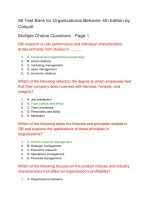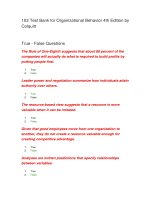Organizational behavior 4th by MShean chap006
Bạn đang xem bản rút gọn của tài liệu. Xem và tải ngay bản đầy đủ của tài liệu tại đây (395.01 KB, 28 trang )
6
Applied Performance
Practices
McGraw-Hill/Irwin
© 2008 The McGraw-Hill Companies, Inc. All rights reserved.
Applied Performance Practices at Nucor
Courtesy Nucor
Nucor has survived and thrived in the turbulent steel
industry through the benefits of performance-based
rewards, job design, and empowerment.
McShane/Von Glinow OB4e
Slide 6-2
© 2008 The McGraw-Hill Companies, Inc. All rights reserved.
Financial Reward Practices
• Money has multiple meanings
– Symbol of success
– Reinforcer and motivator
– Source of reduced anxiety
• Meaning of money varies
– Higher value to men than to women
– Cross-cultural differences
© Corel Corp. With permission.
McShane/Von Glinow OB4e
Slide 6-3
© 2008 The McGraw-Hill Companies, Inc. All rights reserved.
Types of Rewards in the Workplace
•
•
•
•
Membership and seniority
Job status
Competencies
Performance-based
© Corel Corp. With permission.
McShane/Von Glinow OB4e
Slide 6-4
© 2008 The McGraw-Hill Companies, Inc. All rights reserved.
Membership/Seniority Based Rewards
• Fixed wages, seniority increases
• Advantages
– Guaranteed wages may attract job applicants
– Seniority-based rewards reduce turnover
• Disadvantages
– Doesn’t motivate job performance
– Discourages poor performers from leaving
– May act as golden handcuffs
McShane/Von Glinow OB4e
Slide 6-5
© 2008 The McGraw-Hill Companies, Inc. All rights reserved.
Job Status-Based Rewards
• Includes job evaluation and status perks
• Advantages:
– Job evaluation tries to maintain pay equity
– Motivates competition for promotions
• Disadvantages:
– Employees exaggerate duties, hoard resources
– Focuses employees on own jobs, not customers
– Inconsistent with workplace flexibility
McShane/Von Glinow OB4e
Slide 6-6
© 2008 The McGraw-Hill Companies, Inc. All rights reserved.
Competency-Based Rewards
• Pay increases with competencies acquired and
demonstrated
• Skill-based pay
– Pay increases with skill modules learned
• Advantages
– More flexible work force, better quality,
consistent with employability
• Disadvantages
– Potentially subjective, higher training costs
McShane/Von Glinow OB4e
Slide 6-7
© 2008 The McGraw-Hill Companies, Inc. All rights reserved.
Performance Pay at Hugo Boss
Hugo Boss Industries (HBI) attributes
relies on a balanced scorecard that
captures diverse performance
measures across the Swiss
company’s various product groups.
“The scorecard serves a very
important purpose in focussing
attention on the things that are being
measured and where we are trying to
go,” explains Werner Lackas, HBI’s
head of operations.
McShane/Von Glinow OB4e
Slide 6-8
© 2008 The McGraw-Hill Companies, Inc. All rights reserved.
Performance-Based Rewards
•
Organizational •
•
rewards •
Profit sharing
Stock ownership
Stock options
Balanced scorecard
Team • Bonuses
rewards • Gainsharing
• Bonuses
Individual • Commissions
rewards • Piece rate
McShane/Von Glinow OB4e
Slide 6-9
© 2008 The McGraw-Hill Companies, Inc. All rights reserved.
Evaluating Organizational Rewards
• Positive effects
– Creates an “ownership culture”
– Adjusts pay with firm's prosperity
– Scorecards align rewards with several specific organizational
outcomes
• Concerns with performance pay
– Weak connection between individual effort and rewards
– Reward amounts affected by external forces
McShane/Von Glinow OB4e
Slide 6-10
© 2008 The McGraw-Hill Companies, Inc. All rights reserved.
Improving Reward Effectiveness
• Link rewards to performance
• Ensure rewards are relevant
• Team rewards for interdependent
jobs
• Ensure rewards are valued
• Watch out for unintended
consequences
© Corel Corp. With permission.
McShane/Von Glinow OB4e
Slide 6-11
© 2008 The McGraw-Hill Companies, Inc. All rights reserved.
Job Design
• Assigning tasks to a job, including the
interdependency of those tasks with other
jobs
• Organization's goal -- to create jobs that allow
work to be performed efficiently yet
employees are motivated and engaged
McShane/Von Glinow OB4e
Slide 6-12
© 2008 The McGraw-Hill Companies, Inc. All rights reserved.
Job Specialization
• Dividing work into separate jobs that include a subset of
the tasks required to complete the product or service
• Scientific management
– advocates job specialization
– also emphasized person-job matching, training, goal
setting, work incentives
McShane/Von Glinow OB4e
Slide 6-13
© 2008 The McGraw-Hill Companies, Inc. All rights reserved.
Evaluating Job Specialization
Advantages
• Less time changing
activities
• Lower training costs
• Job mastered quickly
• Better person-job
matching
McShane/Von Glinow OB4e
Disadvantages
•
•
•
•
•
Slide 6-14
Job boredom
Discontentment pay
Higher costs
Lower quality
Lower motivation
© 2008 The McGraw-Hill Companies, Inc. All rights reserved.
Job Characteristics Model
Core Job
Characteristics
Critical
Psychological
States
Outcomes
Work
motivation
Skill variety
Task identity
Task significance
Meaningfulness
Autonomy
Responsibility
General
satisfaction
Feedback
from job
Knowledge
of results
Work
effectiveness
Growth
satisfaction
Individual
differences
McShane/Von Glinow OB4e
Slide 6-15
© 2008 The McGraw-Hill Companies, Inc. All rights reserved.
Job Rotation
• Moving from one job
to another
• Benefits
Job ‘A’
– Minimizes repetitive
strain injury
– Multiskills the
workforce
– Potentially reduces job
boredom
McShane/Von Glinow OB4e
Job ‘B’
Job ‘D’
Job ‘C’
Slide 6-16
© 2008 The McGraw-Hill Companies, Inc. All rights reserved.
Job Enlargement
• Adding tasks to an existing job
• Example: video journalist
Traditional news team
Video journalist
Employee 1
Operates camera
• Operates camera
• Operates sound
• Reports story
Employee 2
Operates sound
Employee 3
Reports story
McShane/Von Glinow OB4e
Slide 6-17
© 2008 The McGraw-Hill Companies, Inc. All rights reserved.
Job Enrichment
Given more responsibility for scheduling,
coordinating, and planning one’s own work
1. Clustering tasks into natural groups
– Stitching highly interdependent tasks into one job
– e.g., video journalist, assembling entire product
2. Establishing client relationships
– Directly responsible for specific clients
– Communicate directly with those clients
McShane/Von Glinow OB4e
Slide 6-18
© 2008 The McGraw-Hill Companies, Inc. All rights reserved.
Kambuku Empowerment
Pretoria Portland Cement
introduced “Kambuku”, a
companywide initiative
that made the South
African company more
performance-oriented
through employee
empowerment.
Courtesy Pretoria Portland Cement
McShane/Von Glinow OB4e
Slide 6-19
© 2008 The McGraw-Hill Companies, Inc. All rights reserved.
Dimensions of Empowerment
Selfdetermination
Meaning
Employees believe their work is
important
Competence
Employees have feelings of selfefficacy
Impact
McShane/Von Glinow OB4e
Employees feel they have
freedom and discretion
Employees feel their actions
influence success
Slide 6-20
© 2008 The McGraw-Hill Companies, Inc. All rights reserved.
Supporting Empowerment
• Individual factors
– Possess required
competencies, able to
perform the work
• Job design factors
– Autonomy, task identity, task
significance, job feedback
• Organizational factors
– Resources, learning
orientation, trust
Courtesy Pretoria Portland Cement
McShane/Von Glinow OB4e
Slide 6-21
© 2008 The McGraw-Hill Companies, Inc. All rights reserved.
Self-Leadership
• The process of influencing oneself to establish the
self-direction and self-motivation needed to perform
a task
• Includes concepts/practices from:
– Goal setting
– Social learning theory
– Sports psychology
McShane/Von Glinow OB4e
Slide 6-22
© 2008 The McGraw-Hill Companies, Inc. All rights reserved.
Elements of Self-Leadership
Personal
Goal Setting
Constructive
Thought
Patterns
Designing
Natural
Rewards
SelfMonitoring
SelfReinforcement
• Personal goal setting
– Employees set their own goals
– Apply effective goal setting practices
McShane/Von Glinow OB4e
Slide 6-23
© 2008 The McGraw-Hill Companies, Inc. All rights reserved.
Elements of Self-Leadership
Personal
Goal Setting
Constructive
Thought
Patterns
Designing
Natural
Rewards
SelfMonitoring
SelfReinforcement
• Positive self-talk
– Talking to ourselves about thoughts/actions
– Potentially increases self-efficacy
• Mental imagery
– Mentally practicing a task
– Visualizing successful task completion
McShane/Von Glinow OB4e
Slide 6-24
© 2008 The McGraw-Hill Companies, Inc. All rights reserved.
Elements of Self-Leadership
Personal
Goal Setting
Constructive
Thought
Patterns
Designing
Natural
Rewards
SelfMonitoring
SelfReinforcement
• Finding ways to make the job itself more
motivating
– eg. altering the way the task is accomplished
McShane/Von Glinow OB4e
Slide 6-25
© 2008 The McGraw-Hill Companies, Inc. All rights reserved.









